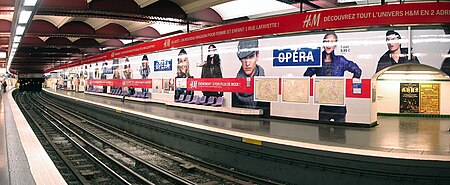Opéra (Paris Métro)

Opéra (French: [ɔpeʁa] (listen)) is a station of the Paris Métro, named after the nearby Opéra Garnier, built by architect Charles Garnier. Located at the end of the Avenue de l'Opéra, one of the accesses being opposite the Opéra, it serves the district of Boulevard Haussmann. Three Métro lines (3, 7 and 8) cross each other at one point, known as a "well". The station offers a connection to the following stations: Auber on RER A, Haussmann–Saint-Lazare on RER E, Havre – Caumartin on Line 3 and Line 9, Saint-Augustin on Line 9, as well as Saint-Lazare on Line 3, Line 12, Line 13 and Line 14. The station is famous for its strong odours of sewers. When it was being built, there were concerns that one of Hector Guimard's characteristic iron metro entrances would spoil the view of the opera house, so a marble entrance was built instead.
Excerpt from the Wikipedia article Opéra (Paris Métro) (License: CC BY-SA 3.0, Authors, Images).Opéra (Paris Métro)
Boulevard des Capucines, Paris 2nd Arrondissement (Paris)
Geographical coordinates (GPS) Address External links Nearby Places Show on map
Geographical coordinates (GPS)
| Latitude | Longitude |
|---|---|
| N 48.870636 ° | E 2.3323526 ° |
Address
Opéra
Boulevard des Capucines
Paris, 2nd Arrondissement (Paris)
Ile-de-France, France
Open on Google Maps










